
This is the 7th section of a primer on astrology, a multifaceted discipline that I consult when developing and refining the characters and timelines in my fictional works. While I am not a professionally trained astrologer, I’ve been studying astrology independently for nearly three decades. This primer is not a complete guide to astrology, but offers readers a basic understanding of an astrological chart.
Catch up on previous astrology blogs
Astrology—The Planets Astrology—The Signs (Part 1) Astrology—The Signs (Part 2) Astrology—The Signs (part 3) Astrology—The Aspects Astrology—Aspect Patterns
The placement of the sun, moon, and planets at the time of birth forms a visible pattern on an astrological chart, a pattern that can give us a bird’s-eye view of the subject’s personality. This section covers the different chart patterns, also sometimes referred to as chart shapes, that are accepted by most astrologers. Most astrological charts fit into one of eight widely accepted chart patterns—seven defined by astrologer Marc Edmund Jones in the 1940s, with two additional patterns discovered by Robert Carl Jansky—but not all of them. These patterns can reveal how the energies within an individual’s chart play against one another but include neither asteroids nor astrological points, like nodes. While aspect patterns may only include a few planets, all the planets are included when describing a chart pattern.
Bundle or Wedge

A bundle chart, sometimes referred to as a wedge, has all the planets clustered together in a 120-degree section of the chart. In most cases, this is within four or fewer adjacent signs and houses. American actor and action-adventure icon Harrison Ford, born on July 13, 1942, has a bundle chart, with the majority of his planets focused on the ninth and tenth houses, the houses of philosophy, travel, and career.
A bundle chart pattern indicates an individual with an intense focus in one area of their life, sometimes to the exclusion of other areas of their lives. This pattern can wedge an individual into very specialized fields, but often denotes an individual who can be exceptionally successful within that chosen field. All signs, planets, angles, and patterns have both positives and negatives, however. While this type of intense focus can lead to great accomplishment, it can also result in a narrow outlook on life and even obsessive thoughts or behaviors.
Bowl
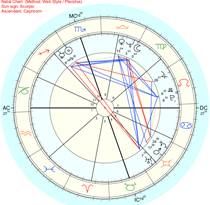
If all the planets are contained within one half of the chart (180 degrees) the chart is said to have a bowl shape. In many cases, the rims of the bowl chart, or the two planets furthest from one another, are also opposite each other. The opposition between the two rims of an astrological bowl chart is often more prominent than other oppositions. Tennis champion Billie Jean King, born November 22, 1943, has a bowl chart with the rims of the bowl defined by Mercury in Sagittarius opposite Uranus in Gemini.
Individuals with a bowl pattern in their charts tend to be highly independent but may feel as if something is missing in their life. They are often acutely aware of both their weaknesses, typically represented by the empty half of their chart and of their strengths, represented by the half of the chart that the planets are housed in. To alleviate this uneven or empty feeling, the chart-holder may seek experiences or partners that balance the unevenness in their chart.
Splash

A splash chart pattern has planets in at least seven different signs, which are spread across at least seven different houses. Charts containing stelliums or more than two conjunctions would typically be excluded from this category. George Harrison of Beatles fame, born on February 25, 1943, has a classic splash pattern.
A splash pattern chart indicates an open-minded individual with a variety of interests and skills that they are typically quite willing to share with others. This diversity of interests may dilute their attention however, sometimes resulting in difficulty with focusing on a single task or goal or bringing projects to completion.
Locomotive
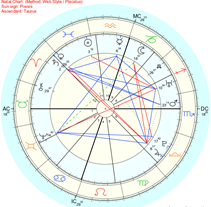
George Washington’s Birth chart February 22, 1732, 10:00 AM Westmoreland, VA
Planets in a locomotive pattern are spread out through three-quarters of the chart, leaving a void in the chart approximately 120 degrees wide. According to Jansky, other than this void, there should not be any break in the locomotive larger than 65 degrees. Founding father George Washington, born February 22, 1732, has a chart with a locomotive pattern, led by Jupiter in Libra.
This formation shows a dynamic individual and self-starter. The leading planet of the locomotive, or the first planet after the gap, counterclockwise, should be noted, as well as the house and sign it is located in. This planet and the sign it’s located in often provide the driving force of the locomotive, while the house shows what area of their life it is focused toward. People with a locomotive chart, like those with a bowl chart, may feel like something is missing from their lives.
See-saw

Charts with two opposing clusters of planets paired with two opposing empty areas that are each at least 60 degrees wide are known as a seesaw pattern, though some astrologers prefer Robert Carl Jnasky’s term for this shape—the hourglass. The clusters of planets should be each include greater than two and fewer than eight. Crooner Frank Sinatra, born December 12, 1915, has a chart with a clear example of a seesaw chart pattern.
Individuals with this chart pattern may find it difficult to weigh and balance the two opposing sides of their chart, frequently see-sawing back and forth between them. Dealing with this duality on a regular basis gives individuals with a see-saw pattern chart an edge when it comes to mediating arguments. The tension caused by the opposition of the two clusters can lead to great achievements.
Bucket
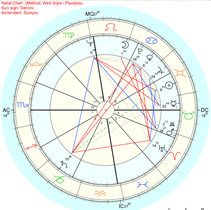
In a bucket pattern, the majority of the planets are restricted to one half of the chart, similar to the bowl, but with a single planet separated from all of the others by at least 60 degrees. The handle of the bucket shape may occasionally be two or three planets in close conjunction with one another, but this is rare. American actor Clint Eastwood, born May 31, 1930, has a bucket chart with Saturn as the handle.
Like a bowl chart, this configuration indicates that the chart holder is a capable and independent individual, but they may also feel that something is missing in their lives. The handle of the bucket is typically the point of focus for the chart. This can manifest in more than one way, depending on the planets and angles involved. For some individuals with this configuration, the energy indicated by the planet or planets that make up the handle alleviates some of that feeling that something is missing, but for others, it may intensify it.
Splay
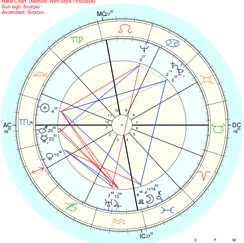
The splay pattern is characterized by three distinct sections or clusters of planets with three empty areas that are each approximately 30-60 degrees wide. Jansky referred to this pattern as a tripod rather than a splay. A grand trine is frequently found at the center of a chart with a splay pattern. Virologist Jonas Salk, born October 28, 1914, has a splay pattern chart with a grand trine in water signs.
This rare pattern is the chart of an individualist. A person with this chart pattern tends to resist a highly regimented life, preferring to avoid routine when they can. They typically master a few skills, but the skills may not be closely related to one another. The challenge for the individual with a splay pattern in their chart is to find a way to balance these different skills to reap the greatest benefit from them.
Fan
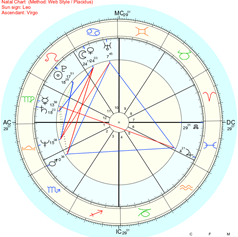
The majority of the planets are clustered together within 120 degrees of one another, similar to the bundle, but with one single planet separated from all the others by at least 60 degrees. As with the fan shape, two or three planets in close conjunction (typically within 1-3 degrees) make up the handle. American engineer, programmer, and entrepreneur Stephen Wozniak, born August 11, 1950, has a fan pattern with Jupiter as the handle.
This chart shape is not one of the shapes described by Marc Edmund Jones, but was first described by Robert Carl Jansky, a scientist who turned to astrology in 1965, writing several books on the subject. Not only does the fan pattern look a great deal like the bundle pattern, but it also indicates a very similar personality, one with intense focus that can sometimes give rise to a narrow outlook. The handle of the fan indicates an area of life that the chart holder can count on to help them reach their goals.


This blog post gives insightful information about astrology birth chart patterns. Great article! Thank you for sharing this post.
I appreciate that you explained that astrology patterns provide specific meaning for your life. My best buddy told me a couple of days ago that he was planning to have a multifaceted character reading consultation to gather insights and information about his British Horary astrology. He asked if I had thoughts on the best reading approach. I like this instructive character reading guide article for the best planning guide. I’ll tell him he should consult a trusted astrology service to have the best planning.
Astrology’s exploration of overall chart patterns adds an interesting layer to the interpretation of individual birth charts. Patterns like grand trines, T-squares, and stelliums can offer insights into an individual’s inherent strengths, challenges, and life themes. While astrology enthusiasts find value in these patterns, it’s important to approach them with a balanced perspective, combining astrological insights with a healthy dose of critical thinking. Ultimately, chart patterns contribute to the rich tapestry of astrological analysis, allowing for deeper understanding and personal growth.
This blog flawlessly makes sense of the unpredictable association between divine bodies and our feelings. It’s astonishing the way in which soothsaying catches the
embodiment of our reality.
Thank you! I appreciate your kind and beautifully worded comment.
“As someone who’s just starting to explore Astrology-Overall Chart Patterns, your blog has been an excellent resource. The way you explain complex concepts in a simple manner is commendable. Keep up the fantastic work!”
Thank you! I work hard at making the information accessible for everyone and I appreciate the confirmation.
Fantastic explanations of chart patterns that go deep and are easy to understand. As someone with a “Bucket” pattern with the bucket handle of Uranus conjunct the Ascendant from the 12th house, your description: “For some individuals with this configuration, the energy indicated by the planet or planets that make up the handle alleviates some of that feeling that something is missing, but for others, it may intensify it…” completely hits the mark.
For me, it both alleviates and intensifies the energy – a psychic and intuitive kind of energy, which, when it happens, seems to be streaming in from another realm. This energy delivers subliminal information to me that helps me to connect with the “other” on a soul level, be it with a person, place or thing. I now comprehend what is happening when I have these experiences, which are frequent. Thank you for your terrific insight.
I’m glad it’s been helpful. Astrology has helped me to understand and manage many of the contraditions in my impulses as well. I imagine that having Uranus conjunct your Ascendant keeps things consistantly interesting.
Great article! I really enjoyed your insights into the influence of Astrology-Overall Chart Patterns on our lives. Your explanation of the correlation between Astrology-Overall Chart Patterns and [astrology/numerology] was particularly informative. I also run a website, dateofbirthcalculators.com, where we provide various tools related to astrology and numerology. It’s always inspiring to come across informative content like yours that helps people understand the fascinating world of astrology/numerology better. Keep up the excellent work!
Thank you for your kind comments. I love online numerology calculators!